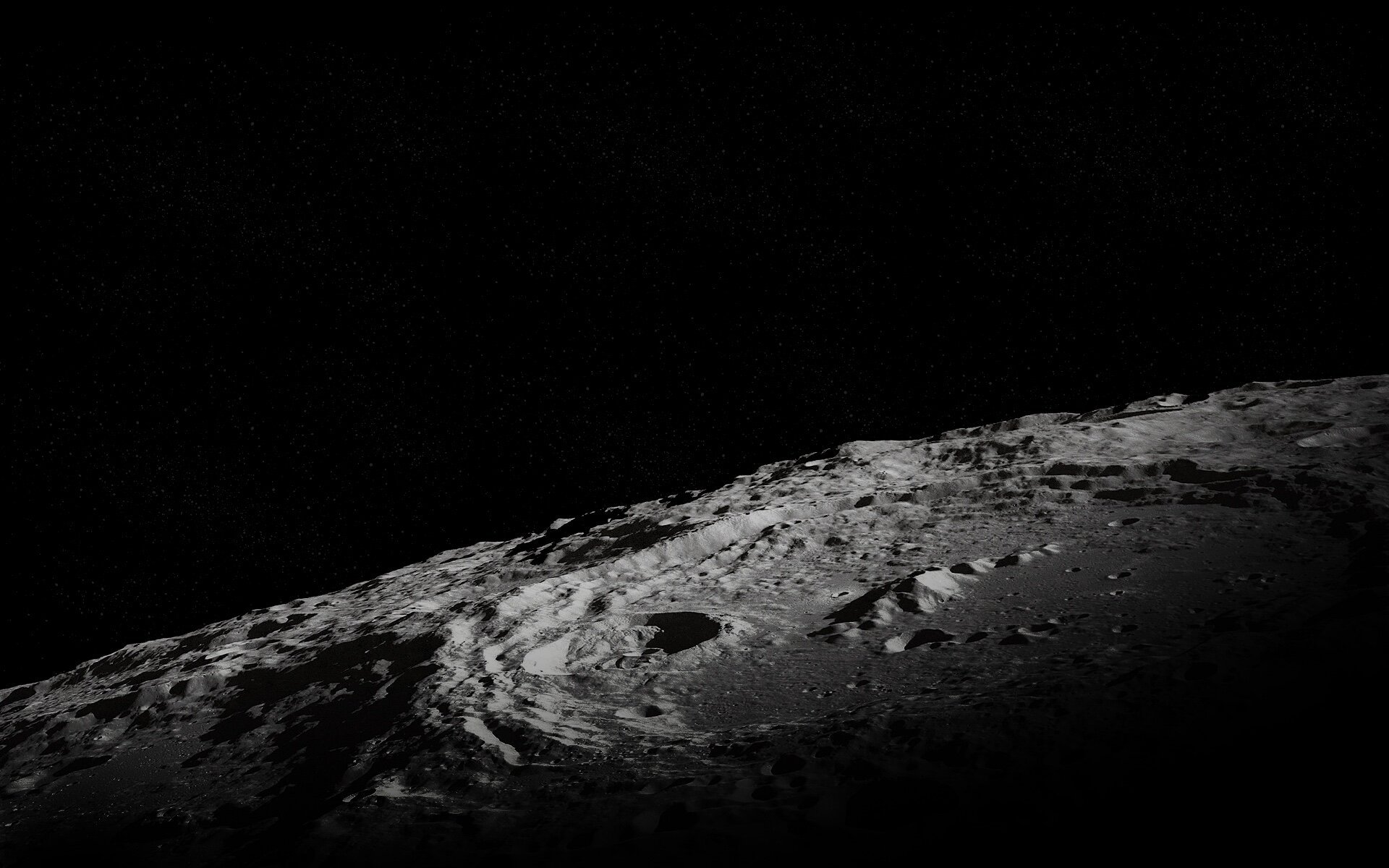Things go dark.
Just like on earth, things go dark. On the moon, a night lasts for 14 Earth-days and some regions of the South Pole haven't been touched by sunlight for billions of years.
But nuclear energy is always on.
We’re building the next generation nuclear reactor that will meet our future energy needs on—and off—Planet Earth.
Lunar Surface Power
The coldest known places in the solar system can be found in the bottom of craters near the moon’s south pole. Parts of these craters haven’t felt the warmth of direct sunlight for billions of years and their permanent shadows cause temperatures to hover around -400 degrees Fahrenheit. The moon’s south pole is inhospitable to the extreme.
It’s also on the shortlist of locations for NASA’s first moonbase.
Continuous power means more time for humans on the moon.
Space exploration and nuclear energy have a long history together, but the full potential of fission energy has yet to be harnessed beyond Earth.

Sustained Moonbases
Nuclear energy will create a sustained human presence on the Moon and there will be long periods of no maintenance needed to the reactor.
Lunar Surface Power
Heat Source
In addition to powering moonbases with electricity, our reactors could provide additional usecases such as a heat source.
Lunar Heat Sources
Self-sustaining Energy
A part of sustained human presence on the moon is a reliable and self-sustained energy source that requires little maintenance.
Energy Uptime
Water in the Darkness
Water is a critical resource for everything from life support to rocket fuel production and it’s an exceedingly rare commodity on the desiccated lunar surface. Permanent shadows at the lunar south pole trap water ice in the darkness, which makes it a prime destination for humans. But building and operating a moonbase, especially one that will be involved with industrial processes like mining and water extraction, requires a lot of energy. If astronauts are ever going to live and work near the lunar south pole or anywhere on the moon they’re going to need nuclear energy to provide a reliable source of baseload power.
At X-energy, we’re building the next generation nuclear reactor that will meet our future energy needs on—and off—Planet Earth.
Space exploration and nuclear energy have a long history together, but the full potential of fission energy has yet to be harnessed beyond Earth. To date, the only sources of nuclear energy in space have been radioisotope thermoelectric generators (RTGs), which can provide a steady drip of electricity for decades by harnessing the heat from the decay of man-made radioactive materials.
RTGs have primarily served as an alternative to solar-powered space applications. Solar power works well for satellites in low Earth orbit or missions in the inner solar system because the sun is rarely out of view. The photon flux is more than sufficient to meet the modest energy needs of a spacecraft.
But just like solar power is only available half the time on Earth, long duration lunar missions must contend with extended periods of weak or inaccessible sunlight. For example, X-energy’s sister company Intuitive Machines has built the world’s first privately developed lunar lander and will fly science payloads to the moon in late 2021 for NASA. Its Nova-C lander is solar powered and is designed to operate for the length of one lunar day. When the lunar night sets in, the spacecraft will go dark until the sun rises again, two Earth-weeks later.
This sort of power outage isn’t an option for future habitable moonbases, which must provide reliable heat and power during the long lunar night—or in regions that never get any direct sunlight at all. RTGs are great for less energy intensive applications like science experiments. All of NASA’s rovers have also been powered by nuclear thermal generators including its latest Mars explorer, Perseverance, which is the first to ever be powered by nuclear fuel made in the US. But unlike RTGs, only a nuclear reactor can crank out the energy that will be needed to sustain a moonbase.
A nuclear reactor differs from an RTG in a few key respects.
Unlike an RTG, a nuclear reactor is not passive. Rather than using heat from a decaying source to produce electricity directly, a nuclear power station uses the energy from nuclear fission to heat a fluid and drive a power convertor to produce electricity. This is not only more energy efficient, it also means a reactor can supply orders of magnitude more power than an RTG. A reactor can also throttle its power output to meet changing energy demands, which is critical for dynamic applications like providing life support to a moonbase. Furthermore, a nuclear reactor can be designed to provide auxiliary services like heating in addition to producing electricity. This could be especially useful for heat-intensive industrial processes on the moon such as sintering regolith to make building materials.
The idea to use nuclear reactors to power a moonbase has deep roots in the space community. NASA has been exploring the concept for decades and even developed a small research reactor to demonstrate its viability. Now that NASA is pursuing going back to the moon and establishing a moonbase by the end of the decade, the agency has prioritized the development of fission-based nuclear reactors for lunar exploration.
Don’t expect to see any cooling towers rising from the mare, however. The reactors of the future—both on Earth and on the moon—are small enough to fit in a rocket fairing and have a modular design that allows them to scale to meet potentially large energy needs with multiple small modules connected to a future lunar grid.
NASA and the Department of Energy have been evaluating their lunar and Mars exploration needs and will be soliciting design concepts for a small, fission-based power generation system that could be delivered to the moon as early as 2026. The system must be capable of delivering at least 10 kilowatts of electric power and operating continuously for at least 10 years. But the entire power plant can’t weigh more than 3,500 kilograms and has to fit on a lunar lander.
X-energy’s innovative design leverages experience with our flagship Xe-100 small modular reactor as well as our terrestrial micro-reactor solutions, but with many advancements and a much smaller size. It’s ideal for lunar surface operations because of its small form factor, scalability to meet evolving needs, advanced technology readiness, and the improved safety from using our meltdown-proof TRISO-X fuel with proliferation resistant high-assay low enriched uranium (HALEU) nuclear fuel.
X-energy is also advancing fuel research for off-world applications.
X-energy is one of the only companies in the US with a federal license to produce ceramic coated fuel forms utilizing HALEU fuel. Our TRISO-X HALEU fuel consists of thousands of grains of uranium wrapped in layers of high temperature ceramics enveloped in billiard ball-sized fuel pebbles and numerous other shapes and sizes that can be customized for many applications, including powering Lunar bases.
We have been working closely with the Department of Energy to safely and reliably manufacture, test, and qualify our TRISO-X fuel for years, which has laid the foundation for fueling our high temperature gas reactors on Earth and beyond.
“Close collaboration with our TRISO-X fuel team and our sister companies who have been planning space missions for years has greatly accelerated our multi-disciplinary design”
— Dr. Brad Rearden (Director of Engineering & X-energy’s solution architect for space reactors)
“Close collaboration with our TRISO-X fuel team and our sister companies who have been planning space missions for years has greatly accelerated our multi-disciplinary design,” says Dr. Brad Rearden, the Director of Engineering and X-energy’s solution architect for space reactors. “We are leveraging lessons learned from other micro-reactor initiatives and leaning on our custom advanced computational toolkit to create a truly innovative solution that can be manufactured, tested, and flown on NASA’s accelerated timeline.”
NASA’s fission surface power (FSP) program requires a company to rapidly produce a functioning reactor for ground testing prior to producing a unit for spaceflight. The aim is to have a fully capable nuclear power station ready to launch to the Moon by late 2026 to lay the foundation for a sustained human presence on the lunar surface by the end of the decade. Designs must also be extendable for human habitats on the surface of Mars. In the past, a five year turnaround time for a nuclear reactor demonstration would have been impossible.
X-energy is well positioned to meet these ambitious timelines because we’ve spent more than a decade developing the advanced nuclear reactors and fuel that will power the future—on Earth and beyond.
Our History with Space
Our family companies are commercializing the ISS & landing on the moon.

What else are we doing in space?
Nuclear Thermal Propulsion
A better Mars rocket








